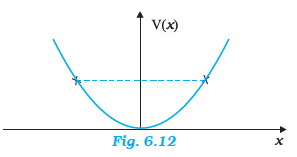The potential energy function for a particle executing linear simple harmonic motion is given by V(x) = kx2/2, where k is the force constant of the oscillator. For k = 0.5 N m-1, the graph of V(x) versus x is shown in Fig. 6.12. Show that a particle of total energy 1 J moving under this potential must ‘turn back’ when it reaches x = � 2 m.

Given,
Total energy of the particle, E = 1 J
Force constant, k = 0.5 N m-1
The total energy is equal to the sum of kinetic energy and potential energy.
So, E = PE + K
⇒ E =  kx2 +
kx2 +  mv2
mv2
So, 1 =  kx2 +
kx2 +  mv2
mv2
When the velocity of the particle is zero i.e., at the turning point, the kinetic energy is zero.
∴ 1 =  kx2
kx2
⇒ x2 = 2/k
⇒ x2 = 2/0.5
⇒ x2 = 4
⇒ x = �2
Hence, the particle turns back at x= �2.
4